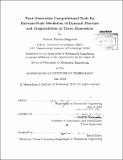| dc.contributor.advisor | Raúl A. Radovitzky. | en_US |
| dc.contributor.author | Seagraves, Andrew Nathan | en_US |
| dc.contributor.other | Massachusetts Institute of Technology. Department of Mechanical Engineering. | en_US |
| dc.date.accessioned | 2013-10-24T17:46:35Z | |
| dc.date.available | 2013-10-24T17:46:35Z | |
| dc.date.copyright | 2013 | en_US |
| dc.date.issued | 2013 | en_US |
| dc.identifier.uri | http://hdl.handle.net/1721.1/81706 | |
| dc.description | Thesis (Ph. D.)--Massachusetts Institute of Technology, Dept. of Mechanical Engineering, 2013. | en_US |
| dc.description | Cataloged from PDF version of thesis. | en_US |
| dc.description | Includes bibliographical references (p. 211-221). | en_US |
| dc.description.abstract | The accurate modeling of dynamic fracture and fragmentation remains one of the most difficult challenges in computational mechanics research. As part of this thesis, a scalable algorithm for modeling dynamic fracture and fragmentation of solids in three dimensions is developed. The method is based on the combination of a discontinuous Galerkin (DG) formulation of the continuum problem and Cohesive Zone Models (CZM) of fracture. Prior to fracture, the flux and stabilization terms arising from the DG formulation at interelement boundaries are enforced via interface elements, much like in conventional approaches based on CZM. Upon the onset of fracture, the traction-separation law (TSL) governing the fracture process becomes operative without the need to propagate topological changes in the mesh as cracks and fragments develop. This enables the indistinctive treatment of crack propagation across processor boundaries and, thus, scalability in parallel computations. Upon crack closure, the reinstatement of the DG terms guarantees the proper description of compressive waves across closed crack surfaces. Another advantage of the method is that it preserves consistency and stability in the uncracked interfaces, thus avoiding issues with wave propagation typical of many CZM-based approaches. The new method is applied in this thesis to conduct the first systematic largescale 3D simulation study of projectile impact damage in brittle plates using CZMs. Utilizing full machine access to supercomputers from the DoD Supercomputing Resource Center (DSRC), we conduct a series of impact simulations at an unprecedented scale aimed at investigating the fundamental physics governing the fracture and fragmentation of brittle plates subjected to normal impact loads. Using the full-field description provided by the simulations, we identify the driving forces for different fracture mechanisms as a function of key problem parameters such as impact speed and plate geometry. In order to validate the computational approach, we also simulate several edge-on impact experiments and compare the simulated cracking patterns directly to experimental results. Another important contribution of this thesis is the first large-scale study of convergence of the fracture patterns predicted in 3D simulations, for which we complete full runs on up to 17,264 processors using meshes comprising up to 2.4 billion degrees of freedom. In addition to the simulation studies, we also develop a fracture mechanics-based model for characterizing radial cracking patterns in thin plates subjected to contact loads. To this end, we derive an approximate closed-form expression for the number of radial cracks which will propagate in an elastic membrane subjected to time-invariant axisymmetric tranverse loads. The model elucidates some of the basic physics governing the radial cracking process and proves useful as a tool for predicting the number of radial cracks in three-dimensional problems involving contact loads. | en_US |
| dc.description.statementofresponsibility | by Andrew Nathan Seagraves. | en_US |
| dc.format.extent | 221 p. | en_US |
| dc.language.iso | eng | en_US |
| dc.publisher | Massachusetts Institute of Technology | en_US |
| dc.rights | M.I.T. theses are protected by
copyright. They may be viewed from this source for any purpose, but
reproduction or distribution in any format is prohibited without written
permission. See provided URL for inquiries about permission. | en_US |
| dc.rights.uri | http://dspace.mit.edu/handle/1721.1/7582 | en_US |
| dc.subject | Mechanical Engineering. | en_US |
| dc.title | Next generation computational tools for extreme-scale simulation of dynamic fracture and fragmentation in three dimensions | en_US |
| dc.type | Thesis | en_US |
| dc.description.degree | Ph.D. | en_US |
| dc.contributor.department | Massachusetts Institute of Technology. Department of Mechanical Engineering | |
| dc.identifier.oclc | 860982820 | en_US |
